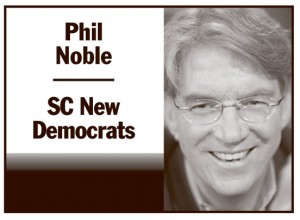‘Understanding each other’s history’ and Rev. Pinckney
Recently in Charleston a large mural of Rev. Clementa Pinckney was unveiled. It was done by 28-year-old Columbia artist Tripp Barnes. It is big and colorful and covers the whole outside wall of a building on St. Phillips Street, a few blocks from my house and from Emanuel AME Church.
In addition to his likeness, the mural also has a short but powerful quote by Clem: “Across the South, we have a deep appreciation of history — we haven’t always had a deep appreciation of each other’s history.”
President Obama quoted these words at Clem’s funeral and it seems that these lines are increasingly being used to define at least part of Clem’s legacy.
So, in the spirit of all of us trying to better understand each other’s history, I’d like to offer a few bits and pieces of a common history — Clem’s and mine — about our shared interest in religion, politics and our neighborhood.
I live at the corner of Pitt and Bull Street right near the College of Charleston. My house was built in about 1886 as the parsonage or home of the ministers of the next door Plymouth Congregational Church. In 1887 over 100 African Americans founded Plymouth and it’s one of the oldest black congregational churches in the South. It is an example of independent black churches formed at the dawn of Emancipation. An early pastor was Francis L. Cardozo (more on him later) and he was also involved in the founding of Avery Normal Institute, an early school for black children.
Over the years, Plymouth pastors who lived in my house were active in anti-lynching and equal rights campaigns. Plymouth also hosted a number of prominent back figures; W.E.B. Du Bois, a founding NAACP member, visited in 1925. Singer and activist Paul Robeson (more on him later, too) stayed here while campaigning for presidential candidate Henry Wallace in 1948. (Full disclosure: the above info is from a state historic marker I helped get erected a few years ago.)
Rev. Francis L. Cardoza was the first African American elected to statewide office in America. He was born in Charleston, the son of Lydia Weston, a free woman of color, and Isaac Cardozo, a Sephardic Jew who worked at the federal customhouse. They had a common-law marriage, as state law prevented their marrying.
Cardozo worked as a carpenter and a shipbuilder and in 1858, he matriculated at the University of Glasgow in Scotland and he later attended seminaries in Edinburgh and London. He was ordained a Presbyterian minister. (So much for stereotypes — then and now — that all Reconstruction Era black politicians were uneducated louts, straight out of the fields.)
He became the first African-American elected to statewide office when he was elected S.C. secretary of state in 1868. He was later elected state treasurer in 1872 and was re-elected twice. When Cardozo was elected treasurer, African-Americans held four of eight statewide executive offices (but not governor) and four of five congressional seats.
Just down Bull Street is the home of Denmark Vesey, the self-freed former slave who was accused of plotting a slave insurrection in 1822. Vesey was pastor of Emanuel AME Church and when the alleged plot was discovered, he and 30 others were hanged and the church burned.
The rebuilt church was the same church where Rev. Pinckney was pastor and where the killings occurred on June 17 — the same date as the planned Vesey rebellion. Vesey’s home at 56 Bull Street is now designated as a National Historic Landmark.
Down Pitt Street in the next block from my house, is the home of Alonso J. Ransier. He was born in Charleston in 1834 as a free person of color. He was elected in 1868 to the S.C. House of Representatives and was also a member of the 1868 state constitutional convention that authorized for the first time a state public school system.
In 1869, Ransier was chosen as head of the S.C. Republican Party after his predecessor, Benjamin F. Randolph, was shot and killed while canvasing the Upstate districts for the presidential campaign of 1868.
In 1870 Ransier was elected the 54th Lieutenant Governor of South Carolina and in 1872 was elected to the U.S. Congress. After leaving Congress in 1875, Ransier was appointed by Republicans as a collector for the Internal Revenue Service. With the end of Reconstruction, he was relegated to menial work and at his death in 1882, he was working as a Charleston street cleaner.
Now for Paul Robeson. The son of a run-away slave, Robeson won an academic scholarship to Rutgers where he became an All-American football player. Then while playing in the NFL, he earned a law degree from Columbia University. He then became a renowned singer and then a stage and screen actor. He toured worldwide and became a global celebrity and was known as “the most famous Negro in the world.”
In 1948, former Vice President Henry Wallace ran for president on the newly formed Progressive Party ticket and he offered the Progressive Vice Presidential nomination to Robeson — but he refused. It was the Truman and Dewey election and Wallace had formed the Progressive Party partly in response to the breakaway anti-civil rights Dixiecrats Party and their candidate for President Strom Thurmond.
When Robeson came to speak at Plymouth, he was campaigning “in the belly of the beast” i.e. Dixiecrat Charleston. His unpopular leftist views had made him a pariah to some and no hotel — black or white — would give him a room. He stayed at the parsonage where upon an angry crowd gathered and threw rocks through the front window. Ironically, Robeson’s wife was the granddaughter of Rev. Cardoza.
So, there you have it, a little bit of Clem’s history — and my history — from our neighborhood.
In South Carolina we have “each other’s” history and we have our shared history, and we need to all try to understand both.
Phil Noble is a businessman in Charleston and president of the S.C. New Democrats, an independent reform group started by former Gov. Richard Riley to bring change and reform. He can be reached at phil@philnoble.com.



























